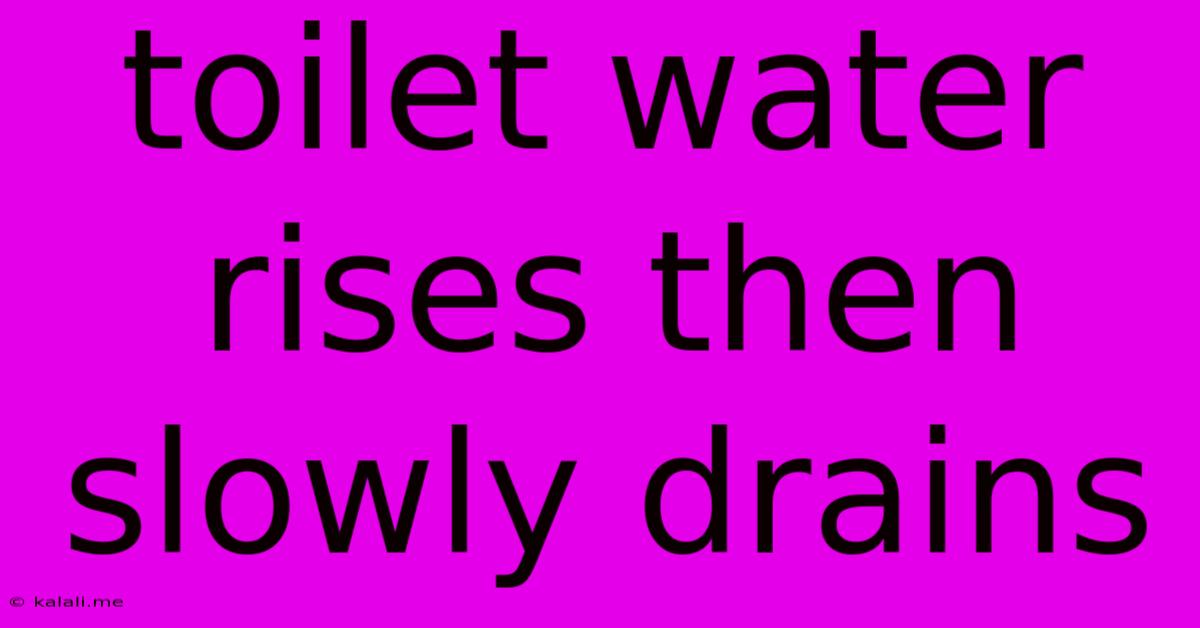Toilet Water Rises Then Slowly Drains
Kalali
May 20, 2025 · 3 min read

Table of Contents
Toilet Water Rises Then Slowly Drains: Troubleshooting and Solutions
Experiencing a toilet that rises and then slowly drains can be a frustrating plumbing issue. This problem often signals a blockage or a more significant plumbing problem that needs immediate attention. This article will guide you through the possible causes and provide practical solutions to get your toilet flushing correctly again.
Possible Causes of a Rising and Slowly Draining Toilet:
Several factors can contribute to this unusual toilet behavior. Let's delve into the most common culprits:
1. Clogged Drain Line: This is the most frequent cause. Hair, toilet paper, hygiene products, and even foreign objects can accumulate in the drain line, restricting water flow. The rising water level indicates a significant blockage preventing proper drainage. The slow drainage is a direct consequence of this partial blockage.
2. Low Water Level in the Tank: An insufficient water level in the tank means the flush won't have enough force to clear the bowl effectively. This often results in a slow drain or even a complete blockage. Check the water level; it should be close to the overflow tube.
3. Faulty Flapper Valve: The flapper valve controls water flow from the tank to the bowl. A damaged or worn flapper valve may not seal properly, allowing water to constantly seep into the bowl, eventually causing it to overflow. This constant water flow, combined with a blockage, can lead to the rising and slow draining issue.
4. Cracked or Broken Drainpipe: A crack or break in the drainpipe beneath the toilet can allow water to seep back into the bowl, increasing the water level. This is often accompanied by a gurgling sound or a musty smell.
5. Bent or Obstructed Trap: The toilet trap, a curved section of the drainpipe under the toilet, can become obstructed or bent, impeding water flow. This can be caused by foreign objects or improper installation.
Troubleshooting and Solutions:
Before calling a plumber, try these troubleshooting steps:
1. Plunging: Use a plunger designed for toilets (a flange plunger is ideal). Create a good seal around the drain opening and plunge vigorously. This may dislodge the blockage. Repeat several times if necessary.
2. Check the Water Level in the Tank: Ensure the water level in the tank is sufficient. The fill valve might be malfunctioning, failing to fill the tank completely. You may need to adjust or replace it.
3. Inspect the Flapper Valve: Remove the tank lid and examine the flapper valve for damage or debris. Clean the valve thoroughly or replace it if necessary. This is often a simple DIY fix.
4. Investigate the Drain Line: If plunging fails, the clog might be further down the drain line. Use a toilet auger (also known as a closet auger) to try and dislodge the blockage. This is a more advanced step and requires caution.
5. Check for Leaks: Carefully inspect the toilet base and surrounding areas for any signs of leaks or cracks in the drainpipe. A leak will often manifest as wet spots or dampness on the floor.
When to Call a Plumber:
If the above troubleshooting steps fail to resolve the issue, or if you suspect a problem with the drainpipe, it's best to call a qualified plumber. Attempting to repair complex plumbing issues without experience can potentially worsen the problem or cause further damage.
By understanding the potential causes and following these troubleshooting steps, you can often resolve the "toilet water rises then slowly drains" issue yourself, saving time and money. However, remember that some plumbing problems require professional intervention for a safe and effective solution.
Latest Posts
Latest Posts
-
Best Time To Trim Leylandii Conifers
May 20, 2025
-
Do You Mix Water With Coolant
May 20, 2025
-
Lego Harry Potter Years 1 4 Cheat Codes
May 20, 2025
-
Can You Use Lard In A Deep Fat Fryer
May 20, 2025
-
What Does Doa Mean In Friends
May 20, 2025
Related Post
Thank you for visiting our website which covers about Toilet Water Rises Then Slowly Drains . We hope the information provided has been useful to you. Feel free to contact us if you have any questions or need further assistance. See you next time and don't miss to bookmark.